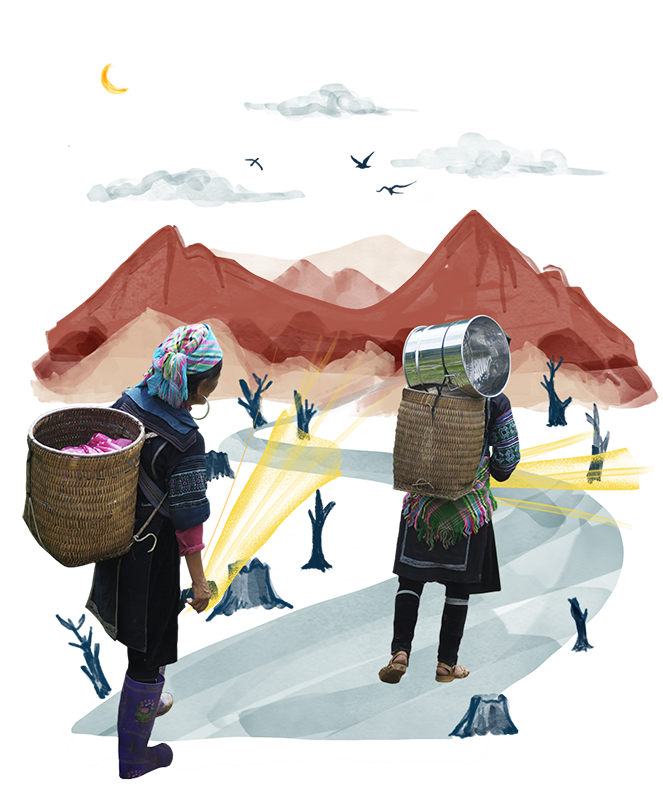Executive Summary
Download the Report
Download a PDF of the full report.When many funders think about impact, they don’t think about gender. Those who do typically view gender as its own discrete program area—a focus that has been vital for improving the lives of women, girls, and gender-expansive people. Yet time and again, the world shows us gender matters in every issue area.
Indeed, the literacy funder who wants to advance reading will want to know that women account for two-thirds of adults globally who are unable to read. 1
 Funders concerned with forced displacement or the environment will care that, of the 20 million people displaced by climate change every year,2 an estimated 80 percent are women.3
Funders concerned with forced displacement or the environment will care that, of the 20 million people displaced by climate change every year,2 an estimated 80 percent are women.3
And funders focused on health care should be aware that women spend 25 percent more time in poor health relative to men. Addressing this health gap would improve women’s lives and boost the global economy by an estimated $1 trillion each year by 2040 as women participate more fully in the workforce.4
To achieve equitable and lasting change, we must pay attention to the on-the-ground realities of how society works—realities that are shaped profoundly by gender. That gendered reality leads to differences in life experiences and outcomes across gender lines—on nearly every issue society faces. And gender inequity is compounded, dramatically, when it intersects with racism, casteism, and other systems of discrimination.
Funders are leaving impact on the table
In 2021-2022, US donors made roughly 200 grants of $25 million or more to social change causes. Just 16 percent named gender as an explicit focus of their grants.5
 Without question, more funding can and should go to dedicated efforts supporting women and girls. But the opportunity here goes far beyond “gender funders.” It’s an opportunity for every funder. By more consistently bringing a gender lens—paying unique attention to gender balances and biases—to the broader expanse of their giving, funders can accelerate progress on the issues they target in their work, whether livelihoods, climate, health, or any other field.
Without question, more funding can and should go to dedicated efforts supporting women and girls. But the opportunity here goes far beyond “gender funders.” It’s an opportunity for every funder. By more consistently bringing a gender lens—paying unique attention to gender balances and biases—to the broader expanse of their giving, funders can accelerate progress on the issues they target in their work, whether livelihoods, climate, health, or any other field.
What would philanthropy done this way look like? It would mean, on any issue, understanding if, how, and why outcomes vary by gender. It would mean exploring solutions with an eye toward whether they’ll work for women, girls, and gender-expansive people—particularly those who face other forms of inequity. It would mean getting at the root causes—the social norms, narratives, and policies that suppress outcomes for women across fields—to unlock enduring progress. And it would mean pursuing the work in ways that acknowledge the diverse lived experiences, leadership, and genius of women.
Five practices for every funder
In this paper, we explore five practices any funder can apply to increasingly consider gender:
- Understand your starting point. Do you know how outcomes vary by gender in your work? For many funders, the answer will be “no.” We share a framework to help you understand whether your current work is gender unintentional, gender responsive, or gender transformative. Mapping your work to these categories can help you understand how you’re approaching gender in your work today—and which direction you may want to head in next.
- Analyze gender in your issue area. How gender intersects with your issue area may not be obvious. Research the current outcomes by gender together with other dimensions of identity where inequities often exist, such as race, socioeconomic status, ability, and sexual orientation. For the disparities that emerge, what are the root causes?
- Design a portfolio that addresses gender in your issue area. Based on your analysis, who and what will you fund differently? Consider funding more women-led organizations and collaboratives that focus on gender equity, including feminist funds. And choose from many possible strategies that can deepen your impact, from meeting basic needs to addressing root causes over the longer term.
 Invest in women’s leadership. Women leaders bring unique attributes that can help unlock impact in any issue, yet they face distinct barriers to accessing decision-making roles and remaining in them over time. Provide steadfast and flexible funding to women leaders across sectors so they can stay and thrive.
Invest in women’s leadership. Women leaders bring unique attributes that can help unlock impact in any issue, yet they face distinct barriers to accessing decision-making roles and remaining in them over time. Provide steadfast and flexible funding to women leaders across sectors so they can stay and thrive.
- Evolve your organization to support your gender aspirations. To live into the practices above, you may find change within your organization is required. This can include revisiting your organization’s culture, grantmaking processes, measurement, and structure to ensure they align with your gender equity goals.






